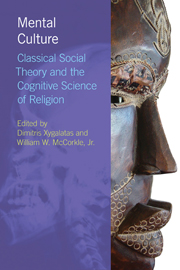Book contents
- Frontmatter
- Contents
- List of illustrations
- Contributors
- 1 Introduction: social minds, mental cultures – weaving together cognition and culture in the study of religion
- 2 Explanatory pluralism and the cognitive science of religion: why scholars in religious studies should stop worrying about reductionism
- 3 Early cognitive theorists of religion: Robin Horton and his predecessors
- 4 The opium or the aphrodisiac of the people? Darwinizing Marx on religion
- 5 Immortality, creation and regulation: updating Durkheim's theory of the sacred
- 6 Non-ordinary powers: charisma, special affordances and the study of religion
- 7 Malinowski's magic and Skinner's superstition: reconciling explanations of magical practices
- 8 Towards an evolutionary cognitive science of mental cultures: lessons from Freud
- 9 Piaget on moral judgement: towards a reconciliation with nativist and sociocultural approaches
- 10 Building on William James: the role of learning in religious experience
- 11 Explaining religious concepts: Lévi-Strauss the brilliant and problematic ancestor
- 12 The meaningful brain: Clifford Geertz and the cognitive science of culture
- 13 Cognitive science and religious thought: the case of psychological interiority in the Analects
- 14 Conclusion: moving towards a new science of religion; or have we already arrived?
- Bibliography
- Index
7 - Malinowski's magic and Skinner's superstition: reconciling explanations of magical practices
- Frontmatter
- Contents
- List of illustrations
- Contributors
- 1 Introduction: social minds, mental cultures – weaving together cognition and culture in the study of religion
- 2 Explanatory pluralism and the cognitive science of religion: why scholars in religious studies should stop worrying about reductionism
- 3 Early cognitive theorists of religion: Robin Horton and his predecessors
- 4 The opium or the aphrodisiac of the people? Darwinizing Marx on religion
- 5 Immortality, creation and regulation: updating Durkheim's theory of the sacred
- 6 Non-ordinary powers: charisma, special affordances and the study of religion
- 7 Malinowski's magic and Skinner's superstition: reconciling explanations of magical practices
- 8 Towards an evolutionary cognitive science of mental cultures: lessons from Freud
- 9 Piaget on moral judgement: towards a reconciliation with nativist and sociocultural approaches
- 10 Building on William James: the role of learning in religious experience
- 11 Explaining religious concepts: Lévi-Strauss the brilliant and problematic ancestor
- 12 The meaningful brain: Clifford Geertz and the cognitive science of culture
- 13 Cognitive science and religious thought: the case of psychological interiority in the Analects
- 14 Conclusion: moving towards a new science of religion; or have we already arrived?
- Bibliography
- Index
Summary
The cognitive science of religion draws upon a broad range of scientific authorities, a point readily made by considering the classic research that the papers in this volume connect to the modern approach to the scientific study of religion. Within that range, it is hard to think of two researchers whose work is more dissimilar than Bronisław Malinowski and B. F. Skinner. Malinowski's anthropological work involved the long-term observation of complex human societies whereas Skinner focused on particular behaviours of individual animals. Malinowski studied people in the natural environment, Skinner relied upon tightly controlled, artificial conditions. Malinowski described his conclusions in elegant prose that ventured broad theories concerning human belief-systems, Skinner eschewed belief talk and aimed for precise theories that were tied tightly to data. Given such differences, the comparison between these two scientific greats could well be used as an antidote against naive views of a monolithic scientific method. The real challenge is how to bring them together, however. This is the kind of problem that researchers engaged in the cognitive science of religion run into constantly due to the highly interdisciplinary character of this field. Looking at how the work of Skinner and Malinowski can be combined usefully provides, therefore, a worthwhile case highlighting the issues that current scientific research into religion has to ind ways of dealing with. Of course, the particular approach pursued here is specific to one researcher and would not be accepted by others in its details.
- Type
- Chapter
- Information
- Mental CultureClassical Social Theory and the Cognitive Science of Religion, pp. 98 - 109Publisher: Acumen PublishingPrint publication year: 2013



